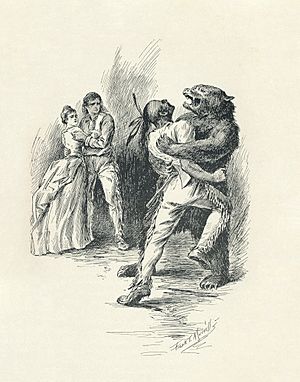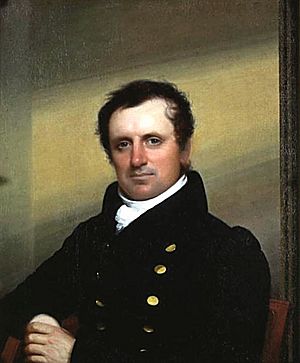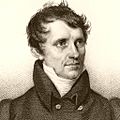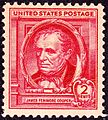James Fenimore Cooper facts for kids
Quick facts for kids
James Fenimore Cooper
|
|
|---|---|
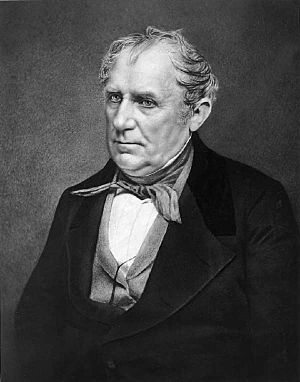
Photograph by Mathew Brady, 1850
|
|
| Born | September 15, 1789 Burlington, New Jersey |
| Died | September 14, 1851 (aged 61) Cooperstown, New York |
| Occupation | Author |
| Genre | Historical fiction |
| Literary movement | Romanticism |
| Notable works | The Last of the Mohicans |
| Military career | |
| Allegiance | |
| Branch | United States Navy |
| Years of service | 1808–1810 |
| Rank | Midshipman |
James Fenimore Cooper (born September 15, 1789 – died September 14, 1851) was a famous American writer. He became well-known and successful for his exciting stories about history. These stories often featured characters from colonial times and Native American people from the 17th to the 19th centuries.
Contents
Early Life and Family
James Fenimore Cooper was born in Burlington, New Jersey, in 1789. He was the eleventh of 12 children born to William and Elizabeth Cooper. Sadly, many of his brothers and sisters passed away when they were very young.
Soon after James's first birthday, his family moved to Cooperstown, New York. This town was actually founded by his father, William Cooper, who bought a large area of land to develop it. Later, his father became a member of the United States Congress, which is part of the government that makes laws for the country.

James went to Yale University when he was 13. However, he left in his third year without finishing his studies. In 1806, at age 17, he started working as a sailor on a merchant vessel (a ship that carries goods). By 1811, he became a midshipman in the new United States Navy. A midshipman was a junior officer in training.
James's father had passed away in 1809. James and his four brothers inherited a large amount of money, investments, and land. However, this inheritance led to many complicated legal issues. On January 1, 1811, when he was 21, James married Susan Augusta de Lancey. Her family was wealthy and had remained loyal to Great Britain during the American Revolution. James and Susan had seven children, and five of them lived to be adults. Their daughter, Susan Fenimore Cooper, became a writer herself. She wrote about nature and women's rights. James helped her by editing her books and finding publishers for them.
His Writings
First Books
In 1820, James was reading a novel to his wife, Susan. He decided he wanted to try writing his own story. This led to his first novel, Precaution (1820), which was set in England. It focused on good behavior and manners, similar to the style of writer Jane Austen. Precaution was published without his name on it and received some good reviews in the United States and England.
His second novel, The Spy (1821), was very different. It was inspired by an American story told to him by his neighbor, John Jay. This book became the first novel written by an American author to be a huge success both at home and in other countries. It had to be printed many times because so many people wanted to read it!
Because of his growing popularity, Cooper published The Pioneers in 1823. This was the first book in his famous Leatherstocking Tales series. This series tells the story of an amazing friendship between Natty Bumppo, a skilled American woodsman, and Chingachgook, the chief of the Delaware Indians. Natty Bumppo was also the main character in Cooper's most famous novel, The Last of the Mohicans (1826). This book was written while Cooper and his family lived in New York City from 1822 to 1826. The Last of the Mohicans became one of the most widely read American novels of the 19th century.
In 1823, Cooper joined the American Philosophical Society in Philadelphia, a group of important thinkers. He also started the Bread and Cheese Club. This club brought together many American writers, artists, scholars, and other important people.
In 1824, a French general named Lafayette visited New York City as a special guest of the United States. Cooper was there to see his arrival and helped organize the welcoming events.
Time in Europe
In 1826, Cooper moved his family to Europe. He hoped to earn more money from his books there. He also wanted his children to get a better education, improve his own health, and see European customs and politics for himself. While living overseas, he continued to write. Some of his books published in Paris include The Prairie, which was the third Leatherstocking Tale. In this book, Natty Bumppo passes away in the western lands that the U.S. had recently bought (the Louisiana Purchase). He also published The Red Rover and The Water Witch, which were two of his many exciting sea stories.
Return to America

In 1833, Cooper came back to the United States. He published a book called "A Letter to My Countrymen," where he shared his thoughts and criticisms about American society and politics.
On May 10, 1839, Cooper published History of the Navy of the United States of America. He had planned to write this important book for a long time.
Historical and Sea Stories
Cooper's history of the U.S. Navy was well-received. However, his descriptions of the American leaders in the Battle of Lake Erie caused disagreements with their families for many years.
In 1846, Cooper published Lives of Distinguished American Naval Officers. This book included biographies of important naval figures like William Bainbridge and Edward Preble. Cooper passed away in 1851. After his death, more of his writings were published, including Old Ironsides in 1853, which was a history of the Navy ship USS Constitution. In 1856, his History of the Navy of the United States of America was re-published in a larger edition. Today, naval historians recognize this work as a very important and reliable account of the U.S. Navy in the early 19th century.
Later Life
In his last ten years, Cooper wrote even more books than before. This was partly because he faced competition from younger writers and new ways of publishing, like magazines. Also, new technologies made books cheaper, so he wrote more to keep up. Half of his 32 novels were written in the 1840s. These books can be put into three main groups: stories about Native Americans, sea adventures, and books about politics and society. Sometimes, these topics overlapped.
The 1840s started with the last two novels featuring Natty Bumppo: The Pathfinder (1840) and The Deerslayer (1841). Both were very popular with readers and critics. Wyandotte, his last novel set during the Revolutionary War, came out in 1843, followed by Oak Openings in 1848. His sea stories from this time included Mercedes of Castile (1840), The Two Admirals (1842), Wing-And-Wing (1842), Afloat and Ashore (1844), Jack Tier (1848), and The Sea Lions (1849).
He also wrote books that combined storytelling with his opinions on social issues. His Littlepage Manuscripts series—Satanstoe (1845), The Chainbearer (1845), and The Redskins (1846)—talked about land ownership problems. These books were a response to conflicts where renters opposed long leases in old Dutch settlements. He also tried writing for magazines with The Autobiography of a Pocket Handkerchief (1843), which made fun of people who suddenly became rich. In The Crater; or, Vulcan's Peak (1847), he used a fantasy setting to show how an ideal society could fall apart when bad leaders take over. The Ways of the Hour, his last finished novel, was a mystery about a young woman defending herself against criminal charges.
Cooper spent his final years back in Cooperstown. He passed away on September 14, 1851, just one day before his 62nd birthday. He was buried in the Christ Episcopal Churchyard, next to his father, William Cooper. His wife, Susan, passed away a few months later and was buried beside him.
Six months after his death, in February 1852, many famous writers, politicians, and public figures held a memorial for Cooper in New York. Daniel Webster gave a speech, and Washington Irving and William Cullen Bryant also spoke. Bryant's speech helped to improve Cooper's reputation among American writers at that time.
Legacy


James Fenimore Cooper was one of the most popular American authors of the 19th century. His work was admired all over the world. For example, the Austrian composer Franz Schubert wanted to read more of Cooper's novels while he was on his deathbed. The famous French novelist Honoré de Balzac greatly admired him. Even Henry David Thoreau, another important American writer, used some of Cooper's writing style in his own work.
Cooper was one of the first major American novelists to include African, African-American, and Native American characters in his stories. Native Americans play very important roles in his Leatherstocking Tales. He showed different sides of Native American characters. For example, in The Last of the Mohicans, he created Magua, who betrays others because he fears his people will disappear. But he also created Chingachgook, the last chief of the Mohicans, who is shown as noble, brave, and heroic, and a good friend to Natty Bumppo.
In 1831, Cooper was chosen as an Honorary Academician by the National Academy of Design.
In 1940, Cooper was honored on a U.S. commemorative stamp as part of the Famous American series.
Three dining halls at the State University of New York at Oswego are named after Cooper (Cooper Hall, The Pathfinder, and Littlepage). This is because he lived in Oswego for a short time and set some of his stories there.
Cooper Park in Michigan's Comstock Township is also named after him.
The New Jersey Turnpike has a service area named after James Fenimore Cooper, recognizing that he was born in that state.
A fancy chandelier in the library of the White House in Washington D.C. came from James Fenimore Cooper's family. It was brought there by First Lady Jacqueline Kennedy during her restoration of the White House. The James Fenimore Cooper Memorial Prize at New York University is given every year to an outstanding journalism student.
In 2013, Cooper was added to the New York Writers Hall of Fame.
Cooper's novels were very popular in other parts of the world, including Russia. The novel The Pathfinder was especially loved by the Russian public. A famous Russian literary critic, Vissarion Belinsky, even called it "a Shakespearean drama in the form of a novel." In Russia, Cooper was often known by his middle name, Fenimore, which sounded exciting to many. This name became a symbol of thrilling adventures for Russian readers. For example, in a 1977 Soviet children's TV show, a mysterious stranger called Fenimore visits a boys' camp at night and tells amazing stories about Native Americans and aliens.
Works
| Date | Title: Subtitle | Genre | Topic, Location, Period |
|---|---|---|---|
| 1820 | Precaution | novel | England, 1813–1814. Stories about upper-class romances. |
| 1821 | The Spy: A Tale of the Neutral Ground | novel | Westchester County, New York, 1780. Conflicts and spying during the Revolutionary War. |
| 1823 | The Pioneers; or, The Sources of the Susquehanna | novel | Leatherstocking Tales, Otsego County, New York, 1793–1794. A story describing early Cooperstown. |
| 1823 | Tales for Fifteen; or, Imagination and Heart | short stories | Moral stories written under the name Jane Morgan. |
| 1824 | The Pilot: A Tale of the Sea | novel | John Paul Jones, England, 1780. The American Revolution at sea. |
| 1825 | Lionel Lincoln; or, The Leaguer of Boston | novel | Boston, 1775–1781. Conflicts between American Patriots and British Loyalists leading to the Battle of Bunker Hill. |
| 1826 | The Last of the Mohicans: A narrative of 1757 | novel | Leatherstocking, French and Indian War, Lake George & Adirondacks, 1757. |
| 1827 | The Prairie | novel | Leatherstocking, American Midwest, 1805. Set in the lands newly acquired by the Louisiana Purchase. |
| 1828 | The Red Rover: A Tale | novel | Newport, Rhode Island & Atlantic Ocean, pirates, 1759. |
| 1828 | Notions of the Americans: Picked up by a Travelling Bachelor | non-fiction | Cooper's response to a request from Lafayette to show America in a good light to Europeans. |
| 1829 | The Wept of Wish-ton-Wish: A Tale | novel | Western Connecticut, Puritans and Native Americans, 1660–1676, during King Philip's War. |
| 1830 | The Water-Witch; or, The Skimmer of the Seas | novel | New York, smugglers, 1713. |
| 1830 | Letter to General Lafayette | politics | Compares France and the U.S. regarding government costs. |
| 1831 | The Bravo: A Tale | novel | Venice, 18th century. About corruption in the Venetian Republic. |
| 1832 | The Heidenmauer; or, The Benedictines, A Legend of the Rhine | novel | German Rhineland, 16th century. About the Protestant Reformation and greed. |
| 1832 | No Steamboats | short story | A story making fun of European misunderstandings about America. Cooper first wrote it in French. |
| 1833 | The Headsman: The Abbaye des Vignerons | novel | Geneva, Switzerland, & Alps, 18th century. |
| 1834 | A Letter to His Countrymen | politics | Explains why Cooper temporarily stopped writing. |
| 1835 | The Monikins | novel | Antarctica, aristocratic monkeys, 1830s. A satire on British and American politics. |
| 1836 | The Eclipse Listen to |
memoir | Solar eclipse in Cooperstown, New York, 1806. Cooper's thoughts on a criminal whose execution was stopped. |
| 1836 | An Execution at Sea | short story | About the execution of a murderer on a ship. Cooper's authorship is sometimes questioned. |
| 1836 | Gleanings in Europe: Switzerland (Sketches of Switzerland) | travel | Hiking in Switzerland, 1828. These "Gleanings" books are full of social and political comments. |
| 1836 | Gleanings in Europe: The Rhine (Sketches of Switzerland, Part Second) | travel | Travels in France, Rhineland & Switzerland, 1832. |
| 1836 | A Residence in France: With an Excursion Up the Rhine, and a Second Visit to Switzerland | travel | |
| 1837 | Gleanings in Europe: France | travel | Living and traveling in France, 1826–1828. Includes the author's involvement in political changes of the time. |
| 1837 | Gleanings in Europe: England | travel | Travels in England, 1826, 1828, 1833. Shows his dislike for the English upper class. |
| 1838 | Gleanings in Europe: Italy | travel | Living and traveling in Italy, 1828–1830. |
| 1838 | The American Democrat; or, Hints on the Social and Civic Relations of the United States of America | non-fiction | About U.S. society and government. |
| 1838 | The Chronicles of Cooperstown | history | Local history of Cooperstown, New York. |
| 1838 | Homeward Bound; or, The Chase: A Tale of the Sea | novel | Atlantic Ocean & North African coast, 1835. The Effingham family returns home from Europe. |
| 1838 | Home as Found: Sequel to Homeward Bound | novel | Eve Effingham and her family experience a new social world in New York City & Templeton/Cooperstown, New York, 1835. |
| 1839 | The History of the Navy of the United States of America | history | History of the U.S. Navy up to that time. |
| 1839 | Old Ironsides | history | History of the Frigate USS Constitution. First published in 1853. |
| 1840 | The Pathfinder; or, The Inland Sea | novel | Leatherstocking Tales, Western New York, 1759. Middle-aged Natty Bumppo falls in love. |
| 1840 | Mercedes of Castile; or, The Voyage to Cathay | novel | Christopher Columbus in the West Indies, 1490s. |
| 1841 | The Deerslayer; or, The First Warpath | novel | Leatherstocking Tales, Otsego Lake, 1740–1745. Natty Bumppo as a young man. |
| 1842 | The Two Admirals | novel | England & English Channel, during the Scottish uprising, 1745. |
| 1842 | The Wing-and-Wing; or, Le Feu-Follet (Jack o Lantern) | novel | Italian coast, Napoleonic Wars, 1799. |
| 1843 | Autobiography of a Pocket-Handkerchief, also published as
|
novelette | A social satire about the newly rich, set in France & New York, 1830s. |
| 1843 | Richard Dale | biography | |
| 1843 | Wyandotté; or, The Hutted Knoll. A Tale | novel | Butternut Valley of Otsego County, New York, Native American romance, 1763–1776. |
| 1843 | Ned Myers; or, Life before the Mast | biography | A biography of Cooper's shipmate who survived a ship sinking in 1813. |
| 1844 | Afloat and Ashore; or, The Adventures of Miles Wallingford. A Sea Tale | novel | Ulster County & worldwide, 1795–1805. |
| 1844 | Miles Wallingford: Sequel to Afloat and Ashore UK title: Lucy Hardinge: A Second Series of Afloat and Ashore (1844) |
novel | Ulster County & worldwide, 1795–1805. |
| 1844 | Proceedings of the naval court martial in the case of Alexander Slidell Mackenzie | Non-fiction | A detailed legal review of Mackenzie's execution of alleged mutineers. |
| 1845 | Satanstoe; or, The Littlepage Manuscripts, a Tale of the Colony | novel | New York City, Westchester County, Albany, Adirondacks, 1758. A prequel to the "anti-rent wars." |
| 1845 | The Chainbearer; or, The Littlepage Manuscripts | novel | Westchester County, Adirondacks, 1780s. The next generation of the Littlepage family tries to settle their lands after the Revolutionary War. |
| 1846 | The Redskins; or, Indian and Injin: Being the Conclusion of the Littlepage Manuscripts | novel | Anti-rent wars, Adirondacks, 1845. The "anti-rent" war in full swing. |
| 1846 | Lives of Distinguished American Naval Officers | biography | |
| 1847 | The Crater; or, Vulcan's Peak: A Tale of the Pacific (Mark's Reef) | novel | Philadelphia, Bristol (PA), & a deserted Pacific island, early 19th century. A story about a perfect society destroyed by political conflict. |
| 1848 | Jack Tier; or, The Florida Reefs a.k.a. Captain Spike; or, The Islets of the Gulf |
novel | Florida Keys, Mexican War, 1846. |
| 1848 | The Oak Openings; or, The Bee-Hunter | novel | Kalamazoo River, Michigan, War of 1812. |
| 1849 | The Sea Lions: The Lost Sealers | novel | Long Island & Antarctica, 1819–1820. Focuses heavily on religion. |
| 1850 | The Ways of the Hour | novel | "Dukes County, New York", a murder/courtroom mystery novel about legal corruption and women's rights, 1846. |
| 1850 | Upside Down; or, Philosophy in Petticoats | play | A play making fun of socialism. |
| 1851 | The Lake Gun | short story | Seneca Lake in New York. A political satire based on local folklore. |
| 1851 | New York; or, The Towns of Manhattan | history | An unfinished history of New York City. First published in 1864. |
Images for kids
-
Photograph by Mathew Brady, 1850
-
Otsego Hall, Cooper's home
-
The young Cooper, in Midshipman's naval uniform
-
The Last of the Mohicans
Illustration from 1896 edition,
by J. T. Merrill -
Cooper's townhouse at 6 St. Mark's Place in the East Village, Manhattan
-
Statue in Cooperstown, New York
-
Cooper was honored on a U.S. commemorative stamp, the Famous American series, issued in 1940
See Also
 In Spanish: James Fenimore Cooper para niños
In Spanish: James Fenimore Cooper para niños


